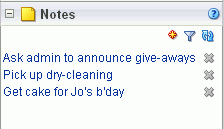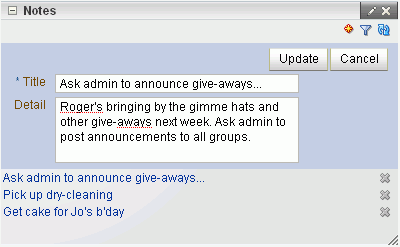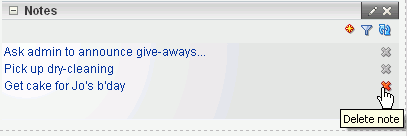24 Working with the Notes Service
This chapter describes the features and functions of the Notes service, and provides specific how-to information about creating personal notes.
Note:
The Notes service is available only in the WebCenter Spaces application, not in custom WebCenter applications.This chapter includes the following sections:
This chapter is intended for WebCenter Spaces users interested in creating personal notes within a WebCenter Spaces application.
The WebCenter Spaces application administrator has the authority to expose or hide a particular service's task flows. Tasks discussed in this chapter are not available to you if the relevant service is hidden.
24.1 What You Should Know About the Notes Service
The Notes service provides useful features for writing yourself reminders in the form of personal notes. Only the notes you create are displayed in the Notes task flow. No other user sees your notes, and you do not see any other user's notes. As you move between spaces, the notes in your view of the Sidebar stay the same.
The Notes service provides two views:
-
The Notes panel in the Sidebar (Figure 24-1)
-
The Notes task flow, which you can add to pages (Figure 24-2)
If you add the Notes task flow to a page in a group space, the task flow displays the personal notes of the currently logged in user.
You can filter your Notes list by note titles. Filtering enables you to narrow the focus of your Notes to just the notes that match your filtering criteria. Consider devising a naming scheme for your notes to make the most of filtering.
24.2 Working with the Notes Service Task Flow
Every work day brings new things that you, and only you, must remember: I before E except after C. Use only bonded 25# paper for your report. John hides his candy in the coffee room stir-stick drawer. WebCenter Spaces offers a way for you to keep track of these useful, sometimes vital, bits of information through Notes.
This section describes how to use the Notes task flow. It contains the following subsections:
24.2.1 Adding a Notes Service Task Flow to a Page
For the steps to add a Notes service task flow to a page, see Section 10.1.4, "Adding Task Flows to a Page."
24.2.2 Creating a Note
Create notes to track personally relevant bits of information, such as your favorite route to the fifth floor, the place to find the most plentiful desk supplies, and so on. This section describes how to create a note.
To create a note:
-
Go to a Notes task flow, and click the Create a new note icon (Figure 24-3).
A panel opens with fields for entering your note (Figure 24-4).
-
In the Title field, enter a note title.
The note title is rendered as a link in the list of notes. You can filter your notes by their titles. Consider devising a naming scheme for your notes to make the most of filtering. For more information about filtering, see Section 24.2.3, "Filtering and Clearing Filters on Notes."
-
In the Detail field, enter note content.
-
Click the Save button to save the note.
When you click Save, the detail panel remains open, allowing you to create additional notes. Once you finish, click Close to exit the panel.
24.2.3 Filtering and Clearing Filters on Notes
Your note list may become lengthy, making it a challenge to find a particular note. In a given session with the Notes task flow, you can shorten the list by filtering out all but the note titles that contain your filtering criteria. Enter a filtering value to temporarily limit display to notes that match the value. You can filter the Notes list against whole or partial words. Filtering looks for matches anywhere in the title.
To clear the filter, click the filtering icon again.
To filter notes:
-
Go to a Notes task flow, and click the Filter notes icon (Figure 24-5).
A filtering toolbar opens (Figure 24-6).
-
Enter your filtering term in the field provided, and then click the Filter icon, next to the field, to apply the filter (Figure 24-7).
Note:
Filtering terms are not case sensitive. Use whole or partial words. Filtering looks for matches anywhere in the title. -
Click the Cancel Filter icon to remove the filter and display all notes (Figure 24-8).
24.2.4 Editing Note Details
Things change. This truism may apply to the details you have entered about a particular note. If so, it's an easy matter to revise note details. This section tells you how.
To edit note details:
-
Go to a Notes task flow, click a note title (Figure 24-9).
Note details display at the top of the task flow (Figure 24-10).
-
Edit the details in the Title and Detail fields as you prefer.
-
Click the Update button to save your changes and exit the edit panel.
24.2.5 Refreshing Your View of Notes
The Notes task flow includes a Refresh notes icon that you can use to refresh your display of notes (Figure 24-11).
This comes in handy for updating your view of the task flow with any recent changes. Click the Refresh notes icon, and the Notes task flow redraws, reflecting recent changes.
24.2.6 Deleting Notes
When a note has outlived its usefulness, you can remove it from the Notes task flow. Each note comes equipped with its own Delete note icon. This section describes how to delete a note.
To delete a note:
-
Go to a Notes task flow, and click the Delete note icon next to the note you want to delete (Figure 24-12).
A Delete Note dialog opens (Figure 24-13).
-
Click the Delete button to delete the selected note.
24.3 Setting Notes Service Task Flow Properties
The Notes service task flow has associated properties, which users with sufficient privileges can access through the Component Properties dialog in Oracle Composer (Figure 24-14). Many properties are common to all task flows, and the method for accessing task flow properties is the same from task flow to task flow. Common task flow properties and how to access them are discussed in Section 10.4, "Setting Properties on Page Content."
The Notes service task flow does not have any unique properties, and therefore no Parameters tab in the Component Properties dialog.
Changes to the properties on the Display Options, Style, and Content Style tabs affect the appearance and behavior of the task flow for all users. These properties are common to all task flows. For more information, see Section 10.4.4, "Working with Component Display Options" and Section 10.4.7, "Working with Style and Content Style Properties."
The content of the Events tab depends on the events supported by the task flow. For more information, see Section 10.4.8, "Working with Component Contextual Events."
The Child Components tab displays all of the components contained within the current component. It provides controls for rearranging, showing, and hiding child components. Not all components contain children. So you may find this tab devoid of content. For more information, see Section 10.4.6, "Working with Child Components."
All properties on the Display Options tab provide access to an Expression Language (EL) editor, which you can use to select or specify a variable value instead of a constant value. Click the Edit icon next to a property field to open the editor. For more information about using the editor and for descriptions of common EL expressions, see Section 10.4.5, "Using Expression Language (EL) Expressions with Component Properties."










